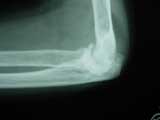 Stiff Elbow |
 Olecranon Bursa |
Pain in the elbow region can arise from elbow joint or adjoining structures or radiate from the neck or shoulder.
Common soft tissue conditions around the elbow are as follows:
- Tennis Elbow (Lateral Epicondylitis): Lateral epicondyle is the outer part of the arm bone (humerus) to which extensor muscles of the forearm are attached. Swelling of these attachments (usually due to overuse) causes localized pain and tenderness. Pain is aggravated by lifting or bending the arm or grasping even light objects such as a cup of tea. The grip can be impaired (e.g., shaking hands) due to this pain. Pain is generally more after exerting the hand. Movements such as gripping, lifting, and carrying heavy objects tend to be troublesome. Tennis elbow is usually self-limiting as the pain settles down over a year in about 80% of patients. Avoidance of overwork and ensuring adequate rest are essential. The use of an elbow strap or brace during work can serve this purpose. Painkillers, local icepacks, and ointments can give some relief. Local injection of corticosteroids, though initially painful, can provide extended pain relief. Early pain relief is desirable as this allows commencement of stretching and other exercises followed by a strength and endurance program. Treatment failure is usually due to failure to remove the cause of the tennis elbow. Nonresponsive disabling symptoms can be treated with surgical measures.
- Golfer's Elbow: Golfer's elbow is a similar condition on the inner (medial) side of the elbow. Flexor muscles of the forearm are attached to the medial epicondyle of the humerus. Pain, therefore, is on the inner side of the elbow and may radiate downwards along the forearm and may be associated with some numbness and tingling in this area. Making a fist (e.g., squeezing a ball) or resisted flexion (e.g., pressing fingers against tabletop) is painful. Treatment is similar to that of the tennis elbow.
- Olecranon Bursitis: Swelling of bursa overlying tip behind elbow ('student's elbow') may cause pain aggravated by pressure. There may be a history of injury to the elbow from behind or repetitive occupational use. However, tender swelling is usually clearly demarcated, and the range of elbow movements is not affected. Needle aspiration of bursa fluid followed by local glucocorticoid injection usually resolves the problem within a week.
Quick Links
Read More Information
General instructions about exercise
Do exercises in fresh, pleasant environment.
It is better to exercise on empty stomach (morning/evening).
Do not eat anything for about an hour after exercise. Sips of water or other fluids are allowed.
Wear comfortable cotton clothes during exercise.
Use proper footwear during exercise. Use of sports or canvas shoes recommended.
Breathe in and out normally from nose. Avoid mouth-breathing.
Concentrate on your exercise and exercise slowly. Never exercise hastily; do not jerk your joints.
Rest for a minute or so if you feel fatigue.
Concentrate on the joint or muscle group for which you are exercising.
Learn exercises, especially those for shoulder, from a physiotherapist.
One should feel relaxation of muscles after exercise. Increase in pain after exercise may indicate wrong method. Stop exercise and meet your physiotherapist again in such situation.
Be relaxed and maintain proper posture during exercise. It is good to look into a mirror during initial days of exercise.
Maintain a posture for about 10 seconds and return back slowly to resting position.
Start low - for some minutes - and increase your work-out gradually.
Exercise one sided limbs at a time initially. Simultaneous exercise for both limbs will be possible after some days.
Exercise twice each day. Regularity is of utmost importance.
Look for a friend if exercising alone gets boring. Exercise accompanied by music is quite entertaining.
Balanced diet is also necessary appropriate benefits of exercise. Meal timings should be strictly adhered to. Consult a dietitian for reducing weight.
General instructions for yoga practice
Yoga postures should be practiced in a clean and fresh surrounding. Do the asanas on a soft and clean mattress. Use clean, light, loose and minimum clothing.
Do the asanas in morning or evening on empty stomach. Eat light food half an hour after completing practice.
Warm-up, in the form of Soorya-namaskar is desirable prior to asanas.
All movements should be gentle and controlled. Do not jerk your body. Do not over-stretch. Do not use any force to overdo.
Watch your breathing. Breathing should be easy and natural. Exhale while you bend forwards and inhale while bending backwards. Never hold breath.
One should be comfortable in any asana. Do whatever little you can. Do not try to overstretch to attain a pose as given in pictures. Trembling during asana implies overdoing.
Steadiness is of utmost importance. Period of staying in a single pose will increase with practice. Try to contract only those muscles that are required for a particular pose while relaxing all other muscles.
Draw your mind away from your body and concentrate on breathing on attaining desired pose.
Select and practice a few asanas and try to master them.
There should not be any pain, fatigue or sweating during asanas. Do a resting asana if any of these appear. One should feel enthusiastic after a yoga session.
45 minutes of yoga practice each day is desirable. Pranayama may also be done for a few minutes. Regularity is the key to success.
Read More Information
